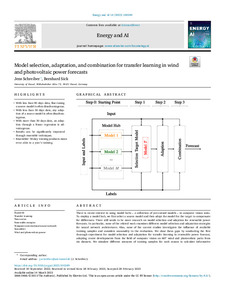| dc.date.accessioned | 2023-07-27T11:15:42Z | |
| dc.date.available | 2023-07-27T11:15:42Z | |
| dc.date.issued | 2023-03-14 | |
| dc.identifier | doi:10.17170/kobra-202307268497 | |
| dc.identifier.uri | http://hdl.handle.net/123456789/14937 | |
| dc.description.sponsorship | Gefördert durch den Publikationsfonds der Universität Kassel | ger |
| dc.language.iso | eng | |
| dc.rights | Namensnennung 4.0 International | * |
| dc.rights.uri | http://creativecommons.org/licenses/by/4.0/ | * |
| dc.subject | transfer learning | eng |
| dc.subject | time series | eng |
| dc.subject | renewable energies | eng |
| dc.subject | temporal convolutional neural network | eng |
| dc.subject | ensembles | eng |
| dc.subject | wind and photovoltaic power | eng |
| dc.subject.ddc | 333 | |
| dc.subject.ddc | 004 | |
| dc.title | Model selection, adaptation, and combination for transfer learning in wind and photovoltaic power forecasts | eng |
| dc.type | Aufsatz | |
| dcterms.abstract | There is recent interest in using model hubs – a collection of pre-trained models – in computer vision tasks. To employ a model hub, we first select a source model and then adapt the model for the target to compensate for differences. There still needs to be more research on model selection and adaption for renewable power forecasts. In particular, none of the related work examines different model selection and adaptation strategies for neural network architectures. Also, none of the current studies investigates the influence of available training samples and considers seasonality in the evaluation. We close these gaps by conducting the first thorough experiment for model selection and adaptation for transfer learning in renewable power forecast, adopting recent developments from the field of computer vision on 667 wind and photovoltaic parks from six datasets. We simulate different amounts of training samples for each season to calculate informative forecast errors. We examine the marginal likelihood and forecast error for model selection for those amounts. Furthermore, we study four adaption strategies. As an extension of the current state of the art, we utilize a Bayesian linear regression for forecasting the response based on features extracted from a neural network. This approach outperforms the baseline with only seven days of training data and shows that fine-tuning is not beneficial with less than three months of data. We further show how combining multiple models through ensembles can significantly improve the model selection and adaptation approach such that we have a similar mean error with only 30 days of training data which is otherwise only possible with an entire year of training data. We achieve a mean error of 9.8 and 14 percent for the most realistic dataset for PV and wind with only seven days of training data. | eng |
| dcterms.accessRights | open access | |
| dcterms.creator | Schreiber, Jens | |
| dcterms.creator | Sick, Bernhard | |
| dc.relation.doi | doi:10.1016/j.egyai.2023.100249 | |
| dc.subject.swd | Transfer | ger |
| dc.subject.swd | Zeitreihe | ger |
| dc.subject.swd | Erneuerbare Energien | ger |
| dc.subject.swd | Convolutional Neural Network | ger |
| dc.subject.swd | Modell | ger |
| dc.subject.swd | Auswahl | ger |
| dc.subject.swd | Anpassung | ger |
| dc.subject.swd | Fotovoltaik | ger |
| dc.subject.swd | Windenergie | ger |
| dc.type.version | publishedVersion | |
| dcterms.source.identifier | eissn:2666-5468 | |
| dcterms.source.journal | Energy and AI | eng |
| dcterms.source.volume | Volume 14 | |
| kup.iskup | false | |
| dcterms.source.articlenumber | 100249 | |


